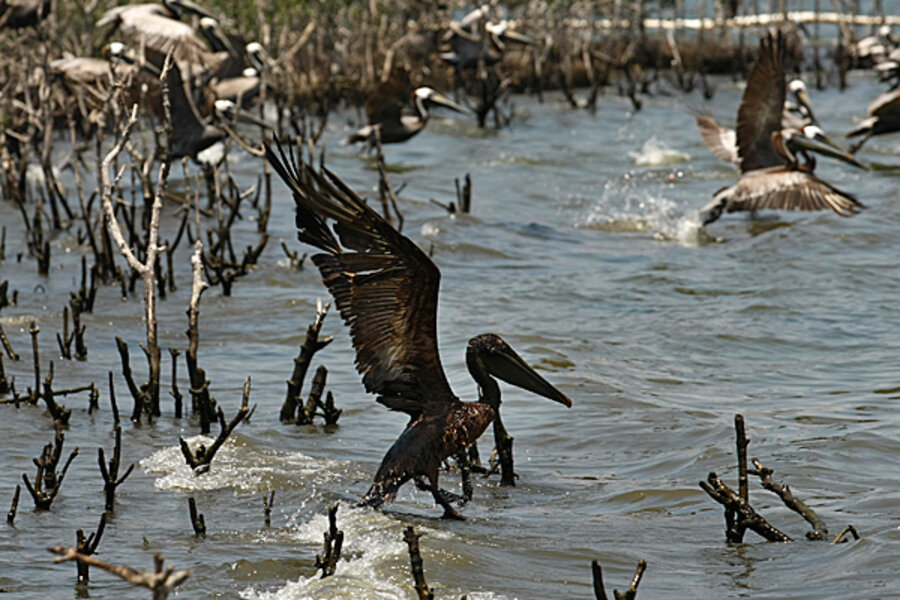BP oil spill: how Gulf's sensitive and endangered species are faring
Loading...
| New Orleans
For the past two days, New Orleanians who start their mornings with The Times-Picayune have seen front-page photographs of oiled brown pelicans, the state bird of Louisiana. The brown pelican had been removed from the threatened-species list just last year, but now, as the BP oil spill washes onto beaches and wetlands, the species is up against a new challenge.
While relatively few numbers of Gulf wildlife have been counted as oil fatalities to date, wildlife experts say the spill could produce mass casualties and steep declines of populations in the coming weeks, months, and years. Of particular concern: bluefin tuna, Kemp’s ridley turtles, and Florida manatees.
“The situation in the Gulf is unprecedented for wildlife, in terms of magnitude and numbers of species involved,” says John Hewitt, senior vice president and directory of husbandry for the Audubon Aquarium of the Americas in New Orleans.
IN PICTURES: The Gulf oil spill's impact on nature
Up to 400 Florida manatees migrate to Louisiana waters each summer, Mr. Hewitt says. This year, the aquatic mammals may be exposed to oil as they swim and forage in the state’s coastal lakes, rivers, and marshes.
“If oil gets into the waterways, we could see a significant impact on the manatees,” Hewitt says. “They’re herbivores, like cows, and have finely tuned digestive tracts. No one knows how this oil could affect the manatees: Nothing has ever occurred on this scale before.”
A record number of manatees – 417– died in Gulf waters last year. Habitat destruction, strikes by boats, cold temperatures, and red tide are cited for most premature deaths of manatees. It is listed by the International Union for Conservation of Nature as vulnerable to extinction.
At the Audubon Aquarium’s rescue center in New Orleans, aquarium specialists are caring for three sea turtles injured by the oil spill. Two are Kemp’s ridley turtles, an endangered species that until recently was threatened with extinction.
Currently, the Gulf has 3,000 nesting pairs of ridleys, Hewitt notes. “They almost disappeared,” he says, “but protection of their nesting areas in northern Mexico, and the use of turtle excluder devices on trawlers in the Gulf, saved them.”
To date, 200 sea turtles of all species have been found dead in the northern Gulf of Mexico since the rig disaster began in April, according to Doug Zimmer of the US Fish and Wildlife Service. Fifteen distressed turtles have been rescued, three with obvious signs of oiling.
However, the causes of the turtle deaths aren’t entirely clear. “Dead turtles are often found in the spring in the Gulf, but marine biologists say this seems to be an uptick in the normal numbers,” Mr. Zimmer says. “Necropsies have been done on 70 of the turtles, but no signs of oil have been found.”
The strandings are nearly five times the average stranding rate over the past five years, according to the National Oceanic and Atmospheric Administration. The majority of stranded turtles are juvenile Kemp's ridley turtles that normally are feeding just offshore. Adult ridleys are mostly nesting on beaches in Mexico this time of year.
Among deepwater species, the western Atlantic bluefin is the most threatened by the Gulf oil spill, according to marine biologists. Weighing close to a ton and reaching 13 feet in length, it is among the fastest of fish and at the top of the ocean’s food chain.
The area of the Deepwater Horizon rig disaster is one of a handful in the Gulf where western Atlantic bluefins breed, accounting for one-quarter of the species’ spawn each spring, says marine biologist Barbara Block of Stanford University in California. The oil spill, she says, will have serious effects on bluefin eggs and larvae, which free float in Gulf waters.
“The spill is so tragic for the bluefin because it happened right at the time of year when the fish come in to breed,” Ms. Block says. “Big fish can sense the oil and swim away. The smaller fish, the eggs and larvae, can’t get away.”
Overfished, the bluefin has undergone an 80 percent decline since the 1970s. In March, the US supported a United Nations effort to ban certain species of bluefin from the international marketplace, but the proposal was blocked by Japan and several African nations. This week, the Center for Biological Diversity filed a formal scientific petition asking for protection of the Atlantic bluefin tuna under the Endangered Species Act.
“When the spill happened, we decided to file this, hoping that the public and the government will have more awareness about the condition of the Atlantic bluefin tuna,” says Catherine Kilduff, an attorney for the environmental group, which is based in Tucson, Ariz. Such protection would require federal agencies that issue drilling permits to avoid jeopardizing critical bluefin habitat, and it would ban the importation of bluefin, she says.
Endangered status for the bluefin would enhance protection of all fish and wildlife in the Gulf – particularly other large fish species such as yellowfin tuna, swordfish, and blue and white marlin, Ms. Kilduff adds.
The spill’s effects on shorebirds, such as the once-endangered pelican, are still pending, says Zimmer of the Fish and Wildlife Service. “We don’t know what’s going to happen,” said Zimmer, who has previously worked on bird rescue operations following oil spills in Oregon and Washington. “We’re dealing with more unknowns than knowns. We’ve never dealt with this type of oil release, with oil doing stuff we’ve never seen before.”
Nearly driven to extinction by use of the pesticide DDT in the 1960s, the brown pelican has rebounded robustly in the Gulf region. But like all shorebirds, it’s particularly vulnerable to oiling, Zimmer says.
“Oil affects their ability to fly,” among other things, he says. “Louisiana has a robust population of pelicans now, but this is a population that has been at risk before.”
IN PICTURES: The Gulf oil spill's impact on nature
Related:





